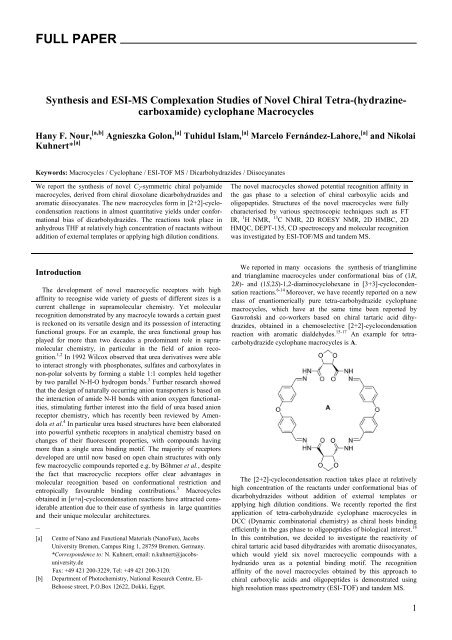The Development of Novel Antibiotics Using ... - Jacobs University
The Development of Novel Antibiotics Using ... - Jacobs University
The Development of Novel Antibiotics Using ... - Jacobs University
You also want an ePaper? Increase the reach of your titles
YUMPU automatically turns print PDFs into web optimized ePapers that Google loves.
FULL PAPER<br />
Synthesis and ESI-MS Complexation Studies <strong>of</strong> <strong>Novel</strong> Chiral Tetra-(hydrazinecarboxamide)<br />
cyclophane Macrocycles<br />
Hany F. Nour, [a,b] Agnieszka Golon, [a] Tuhidul Islam, [a] Marcelo Fernández-Lahore, [a] and Nikolai<br />
Kuhnert* [a]<br />
Keywords: Macrocycles / Cyclophane / ESI-TOF MS / Dicarbohydrazides / Diisocyanates<br />
We report the synthesis <strong>of</strong> novel C 2 -symmetric chiral polyamide<br />
macrocycles, derived from chiral dioxolane dicarbohydrazides and<br />
aromatic diisocyanates. <strong>The</strong> new macrocycles form in [2+2]-cyclocondensation<br />
reactions in almost quantitative yields under conformational<br />
bias <strong>of</strong> dicarbohydrazides. <strong>The</strong> reactions took place in<br />
anhydrous THF at relatively high concentration <strong>of</strong> reactants without<br />
addition <strong>of</strong> external templates or applying high dilution conditions.<br />
<strong>The</strong> novel macrocycles showed potential recognition affinity in<br />
the gas phase to a selection <strong>of</strong> chiral carboxylic acids and<br />
oligopeptides. Structures <strong>of</strong> the novel macrocycles were fully<br />
characterised by various spectroscopic techniques such as FT<br />
IR, 1 H NMR, 13 C NMR, 2D ROESY NMR, 2D HMBC, 2D<br />
HMQC, DEPT-135, CD spectroscopy and molecular recognition<br />
was investigated by ESI-TOF/MS and tandem MS.<br />
Introduction<br />
<strong>The</strong> development <strong>of</strong> novel macrocyclic receptors with high<br />
affinity to recognise wide variety <strong>of</strong> guests <strong>of</strong> different sizes is a<br />
current challenge in supramolecular chemistry. Yet molecular<br />
recognition demonstrated by any macrocyle towards a certain guest<br />
is reckoned on its versatile design and its possession <strong>of</strong> interacting<br />
functional groups. For an example, the urea functional group has<br />
played for more than two decades a predominant role in supramolecular<br />
chemistry, in particular in the field <strong>of</strong> anion recognition.<br />
1,2 In 1992 Wilcox observed that urea derivatives were able<br />
to interact strongly with phosphonates, sulfates and carboxylates in<br />
non-polar solvents by forming a stable 1:1 complex held together<br />
by two parallel N-H-O hydrogen bonds. 3 Further research showed<br />
that the design <strong>of</strong> naturally occurring anion transporters is based on<br />
the interaction <strong>of</strong> amide N-H bonds with anion oxygen functionalities,<br />
stimulating further interest into the field <strong>of</strong> urea based anion<br />
receptor chemistry, which has recently been reviewed by Amendola<br />
et al. 4 In particular urea based structures have been elaborated<br />
into powerful synthetic receptors in analytical chemistry based on<br />
changes <strong>of</strong> their fluorescent properties, with compounds having<br />
more than a single urea binding motif. <strong>The</strong> majority <strong>of</strong> receptors<br />
developed are until now based on open chain structures with only<br />
few macrocyclic compounds reported e.g. by Böhmer et al., despite<br />
the fact that macrocyclic receptors <strong>of</strong>fer clear advantages in<br />
molecular recognition based on conformational restriction and<br />
entropically favourable binding contributions. 5 Macrocycles<br />
obtained in [n+n]-cyclocondensation reactions have attracted considerable<br />
attention due to their ease <strong>of</strong> synthesis in large quantities<br />
and their unique molecular architectures.<br />
__<br />
[a]<br />
[b]<br />
Centre <strong>of</strong> Nano and Functional Materials (NanoFun), <strong>Jacobs</strong><br />
<strong>University</strong> Bremen, Campus Ring 1, 28759 Bremen, Germany.<br />
*Correspondence to: N. Kuhnert, email: n.kuhnert@jacobsuniversity.de<br />
Fax: +49 421 200-3229, Tel: +49 421 200-3120.<br />
Department <strong>of</strong> Photochemistry, National Research Centre, El-<br />
Behoose street, P.O.Box 12622, Dokki, Egypt.<br />
We reported in many occasions the synthesis <strong>of</strong> trianglimine<br />
and trianglamine macrocycles under conformational bias <strong>of</strong> (1R,<br />
2R)- and (1S,2S)-1,2-diaminocyclohexane in [3+3]-cyclocondensation<br />
reactions. 6-14 Moreover, we have recently reported on a new<br />
class <strong>of</strong> enantiomerically pure tetra-carbohydrazide cyclophane<br />
macrocycles, which have at the same time been reported by<br />
Gawroński and co-workers based on chiral tartaric acid dihydrazides,<br />
obtained in a chemoselective [2+2]-cyclocondensation<br />
reaction with aromatic dialdehydes. 15-17 An example for tetracarbohydrazide<br />
cyclophane macrocycles is A.<br />
<strong>The</strong> [2+2]-cyclocondensation reaction takes place at relatively<br />
high concentration <strong>of</strong> the reactants under conformational bias <strong>of</strong><br />
dicarbohydrazides without addition <strong>of</strong> external templates or<br />
applying high dilution conditions. We recently reported the first<br />
application <strong>of</strong> tetra-carbohydrazide cyclophane macrocycles in<br />
DCC (Dynamic combinatorial chemistry) as chiral hosts binding<br />
efficiently in the gas phase to oligopeptides <strong>of</strong> biological interest. 18<br />
In this contribution, we decided to investigate the reactivity <strong>of</strong><br />
chiral tartaric acid based dihydrazides with aromatic diisocyanates,<br />
which would yield six novel macrocyclic compounds with a<br />
hydrazido urea as a potential binding motif. <strong>The</strong> recognition<br />
affinity <strong>of</strong> the novel macrocycles obtained by this approach to<br />
chiral carboxylic acids and oligopeptides is demonstrated using<br />
high resolution mass spectrometry (ESI-TOF) and tandem MS.<br />
1

















